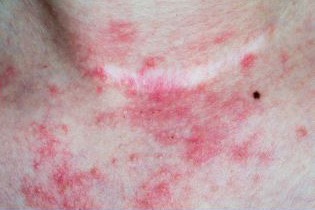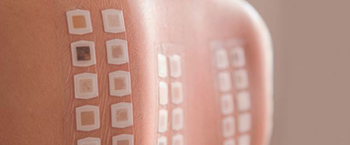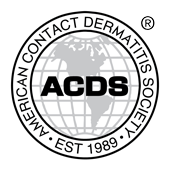Contact Dermatitis FAQ
The American Contact Dermatitis Society (ACDS) was founded in 1989 and has grown from a small dedicated group of dermatologists focused on contact dermatitis to over 2,500 health care professionals specializing in the field of allergic contact dermatitis and related inflammatory skin diseases.
Below are some frequently asked questions regarding contact dermatitis. To find a provider in your area that might specialize in contact dermatitis, please visit the ACDS Find a Provider Directory.
What is Contact Dermatitis?
What are the types of Contact Dermatitis?
How is Contact Dermatitis diagnosed?
What is Patch Testing?
How is Contact Dermatitis treated?
What is the Contact Allergen Management Program (CAMP)?
What should I do if I suspect that I have Contact Dermatitis?
What is Contact Dermatitis?
 Contact dermatitis is a rash that occurs when your skin comes into contact with a substance that causes an immune response. This reaction can happen even to substances that you have used safely for years. It may be difficult to diagnose since contact dermatitis may coexist with or look identical to other kinds of eczema.
Contact dermatitis is a rash that occurs when your skin comes into contact with a substance that causes an immune response. This reaction can happen even to substances that you have used safely for years. It may be difficult to diagnose since contact dermatitis may coexist with or look identical to other kinds of eczema.
Once you have developed a contact allergy, it is often difficult to avoid the culprit allergen without knowing exactly what you need to avoid, since many products are made with similar ingredients, and some substances may be found in many different things.
What are the types of Contact Dermatitis?
- Irritant contact dermatitis occurs in response to irritating substances such as household cleaners, harsh soaps and industrial solvents. Your skin can react to these substances within minutes or hours.
- Allergic contact dermatitis occurs when a person’s immune system responds to contact with something you are allergic to, such as fragrances, preservatives, nickel, and many others. Allergic reactions typically develop anywhere between a day to a couple of weeks after exposure and may take several weeks to heal.
How is Contact Dermatitis diagnosed?
Contact dermatitis should be considered in new cases of eczema, when there are changes in chronic cases of eczema such as in location, severity, or appearance, and whenever eczema isn’t responding to treatment. It may be particularly difficult to identify contact dermatitis in people with atopic dermatitis. Your health care provider may diagnose you with irritant or allergic contact dermatitis based on evaluation of your medical history, exposures, and symptoms, and with a procedure called patch testing.
What is Patch Testing?
 Patch testing is a procedure where allergens are placed on your back for 2 days, then removed. After removal, your back is examined for any reactions. Around two days after removing the patches, you will return to the office again for your second reading. At this time, your provider will determine if it is necessary to perform additional readings after your second reading.
Patch testing is a procedure where allergens are placed on your back for 2 days, then removed. After removal, your back is examined for any reactions. Around two days after removing the patches, you will return to the office again for your second reading. At this time, your provider will determine if it is necessary to perform additional readings after your second reading.
Note that patch testing is not the same as prick testing, which is a different allergy test that is used to diagnose other kinds of allergies, such as hay fever, and is not helpful in diagnosing allergic contact dermatitis.
How is Contact Dermatitis treated?
Treatment of both irritant and allergic contact dermatitis is based on avoiding contact with the substance(s) that caused the reaction. To assist with avoidance of your allergen, various resources exist, such as the American Contact Dermatitis Society’s (ACDS) Contact Allergen Management Program (CAMP). CAMP, which is available to those patients whose provider is an ACDS member, can provide you with a list of safe products to use that is customized to your specific allergies.
Other helpful measures include minimizing your products and protecting your skin barrier using measures such as short lukewarm baths or showers and frequent application of bland fragrance-free moisturizing creams or ointments.
What is the Contact Allergen Management Program (CAMP)?
The ACDS Contact Allergen Management Program (CAMP) is available to ACDS physician members and their respective patients. This web-based resource is designed to help patients with allergic contact dermatitis find personal care products that are free of the ingredients that are causing their allergic reactions. Each safe list generated is personalized for each individual patient. The list is not exhaustive, but is an excellent starting point for patients to find products that will relieve their allergic reactions.
The products included have been uploaded by CAMP administrators using information that is publicly available or voluntarily provided by personal care product companies who are committed to patient safety.
When patients complete their patch testing to determine which ingredients they are allergic to, the ACDS physician member will give the patient CAMP access corresponding to their specific allergens. These codes can then be entered into CAMP. An app can also be downloaded – free of charge – for easy access to your safe list while shopping.
What should I do if I suspect that I have Contact Dermatitis?
Please consult a health care provider. For a listing of providers that perform patch testing, you can access the American Contact Dermatitis Society (ACDS) Find a Provider database

